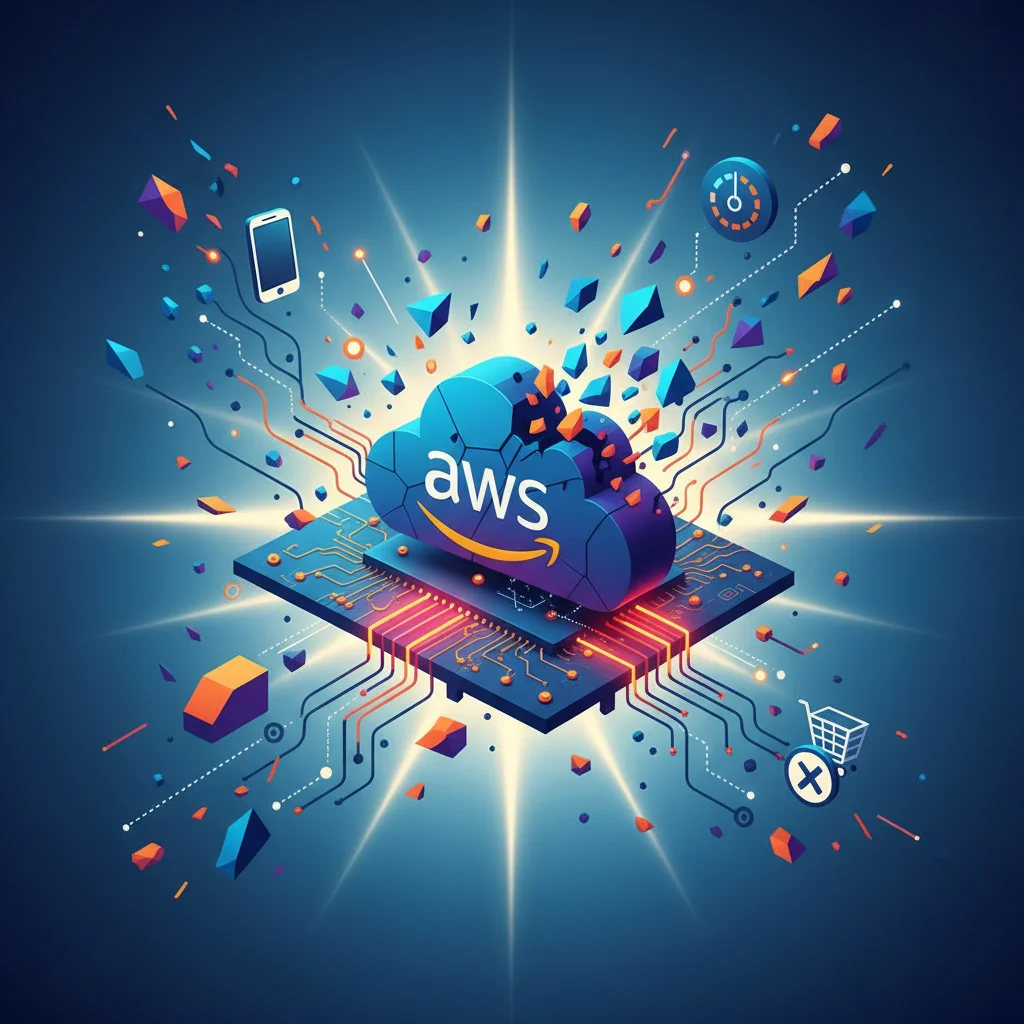
The Day the Internet Stumbled: Decoding the Latest AWS Outage and What It Means for You
Did you feel it? That subtle, yet jarring, digital tremor. The app on your phone that wouldn’t load. The work software that suddenly spun its wheels into oblivion. The e-commerce site that hung on a blank white screen. If you experienced any of this recently, you weren’t alone. You were likely feeling the ripple effects of a widespread outage at Amazon Web Services (AWS), the colossal cloud computing platform that quietly powers a massive chunk of the modern internet.
According to a report from the Financial Times, Amazon’s cloud business was hit by a significant “operational issue” that affected “multiple services.” While the technical jargon might sound mundane, the impact was anything but. This event serves as a critical, and perhaps uncomfortable, reminder of the digital infrastructure’s fragility and our collective dependence on a handful of tech giants. It’s not just about a server going down; it’s about the cascading failure of the services, businesses, and innovations built on top of it.
In this deep dive, we’ll go beyond the headlines to dissect what happened, explore the far-reaching consequences, and provide actionable insights for developers, entrepreneurs, and tech leaders. This isn’t just a post-mortem; it’s a lesson in resilience for the digital age.
The Anatomy of a Digital Blackout
When AWS stumbles, the internet feels it. As the dominant player in the cloud market, holding over 31% of the global market share, its infrastructure is the bedrock for millions of applications. From Netflix streaming your favorite show to the SaaS platform managing your company’s payroll, AWS is the unseen utility.
The recent outage, like many before it, was centered in one of its most critical regions. AWS described the event as an “operational issue,” a broad term that can encompass anything from a flawed software deployment and network configuration error to a physical hardware failure. This wasn’t a malicious cybersecurity event, but a self-inflicted wound—a reminder that human and automation errors can be just as disruptive as any external threat.
The impact wasn’t uniform; it was a chaotic domino effect. Core services responsible for computing power (EC2), data storage (S3), and database management (RDS) experienced elevated error rates. Consequently, a vast array of dependent services and customer applications began to fail. This is the nature of modern cloud architecture: a highly interconnected ecosystem where a problem in one foundational service can trigger a cascade of failures across the entire stack. For developers and IT professionals, it was a sudden, high-stakes scramble to diagnose problems that were entirely outside of their control.
The Price of 'Free': Why Meta's Italian Lawsuit is a Wake-Up Call for the AI-Powered World
A Brief History of Digital Dominoes
While this outage was disruptive, it’s unfortunately not a unique event. The history of cloud computing is punctuated by major outages that have served as painful, but necessary, learning experiences. Understanding these past events provides crucial context for building more resilient systems today.
Here’s a look at some of the most notable cloud outages and their causes:
| Date | Provider & Region | Root Cause | Key Impact |
|---|---|---|---|
| December 2021 | AWS (US-EAST-1) | An automated process to scale capacity caused an unexpected network overload. | Disrupted Delta, Disney+, Ring, and even Amazon’s own delivery logistics during the holiday season. |
| June 2023 | Microsoft Azure (US East) | A networking issue related to a software-defined networking (SDN) update. | Impacted Microsoft 365 services, including Outlook and Teams, affecting millions of business users. |
| November 2020 | AWS (US-EAST-1) | A small error during routine maintenance on the Kinesis Data Streams service. | Took down Adobe, Roku, Flickr, and The Washington Post, highlighting dependencies on less-known services. |
| February 2017 | AWS (US-EAST-1) | Human error: an engineer entered a command incorrectly, intending to remove a few servers but instead removing a large number. | A classic “typo” that caused a massive S3 outage, breaking thousands of websites and applications for hours. |
The pattern is clear: the most common culprits are not external attacks but internal errors in software, configuration, or routine procedures, often in the sprawling and critical US-EAST-1 region. Each incident underscores that 100% uptime is a myth. The real goal is not to prevent failure entirely, but to design systems that can gracefully withstand it.
Building for Resilience: A CTO’s Playbook
For startups and established businesses alike, downtime is more than an inconvenience; it’s a direct hit to revenue, reputation, and customer trust. The cost of just one hour of downtime for a large enterprise can be staggering, often exceeding $300,000. So, what can you do? Waiting for the cloud provider to fix things is not a strategy. True resilience is built into your software architecture from day one.
Key Strategies for a Fault-Tolerant Architecture:
- Multi-AZ is the Baseline, Not the Finish Line: Deploying your application across multiple Availability Zones (AZs) within a single region is standard practice. It protects you from a single data center failure but does nothing for a region-wide service outage. It’s the necessary first step, but it’s not enough.
- Embrace Multi-Region Architecture: For critical applications, a multi-region strategy is the gold standard. This involves replicating your data and infrastructure in a separate, geographically distant AWS region. If US-EAST-1 goes down, you can execute a failover and route traffic to US-WEST-2. This is complex and costly but provides the highest level of availability.
- Design for Graceful Degradation: Your application doesn’t have to be an all-or-nothing proposition. Design it to fail gracefully. If a non-essential feature (like a recommendation engine) relies on a service that’s down, can the rest of your app continue to function? This prevents a partial outage from becoming a total catastrophe.
- Automate Your Failover: A disaster recovery plan sitting in a document is useless if it takes hours to execute manually. True resilience comes from automation. Use infrastructure-as-code (IaC) and automated health checks to detect failures and trigger failover processes in minutes, not hours. This programming and automation effort is a critical investment.
Digital Reckoning: Why an Italian Lawsuit Could Redefine Big Tech's AI Playbook
The AI & Machine Learning Dependency
The stakes of cloud outages are being raised exponentially by the rise of artificial intelligence. Modern AI and machine learning applications are incredibly compute-hungry. Training large language models (LLMs) and running inference at scale requires the kind of massive, on-demand infrastructure that only cloud providers like AWS can offer.
This deep symbiosis means that when the cloud fails, our nascent AI-powered world fails with it. Consider the implications:
- AI-Powered SaaS: Countless software tools that use AI for summarization, content creation, or data analysis will simply break.
- Customer Service Chatbots: The automated agents helping users navigate websites and solve problems will go silent.
- Intelligent Automation: Business processes that rely on machine learning for fraud detection or supply chain optimization will grind to a halt.
As we embed AI deeper into our critical systems, the reliability of the underlying cloud infrastructure becomes a paramount concern. The innovation happening in AI is breathtaking, but it’s being built on the same foundational rails that just proved, once again, to be fallible.
Conclusion: From Fragility to Antifragility
The latest AWS outage is not an indictment of cloud computing. It’s a maturation point. It’s a powerful, industry-wide call to action to move beyond a simple “lift and shift” mentality and embrace a more sophisticated approach to cloud architecture. The cloud is not an infallible utility; it’s a dynamic, complex, and powerful platform that demands respect for its inherent complexities.
For entrepreneurs and startups, this means treating infrastructure resilience as a core product feature, not an afterthought. For developers, it’s a challenge to hone skills in distributed systems, automation, and fault-tolerant programming. For business leaders, it’s about understanding the true cost of downtime and investing proactively in a robust digital foundation.
The internet will stumble again. The question is, when it does, will your services stumble with it, or will they have been designed with the foresight and innovation to stand firm?
The Algorithm on Trial: Why Big Tech's Italian Lawsuit is a Wake-Up Call for All Developers


